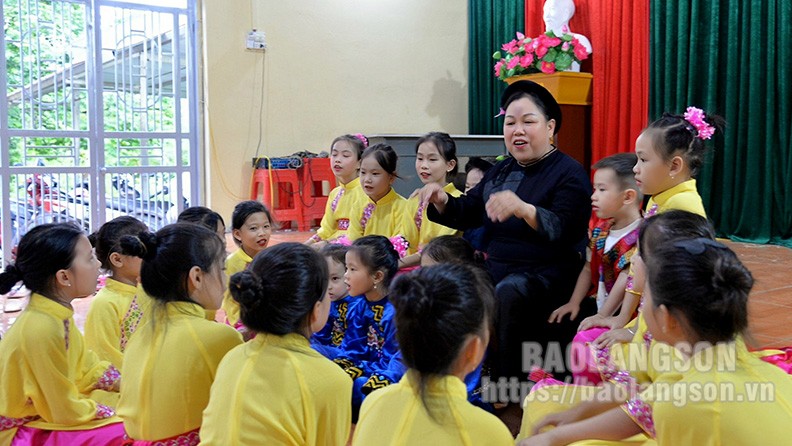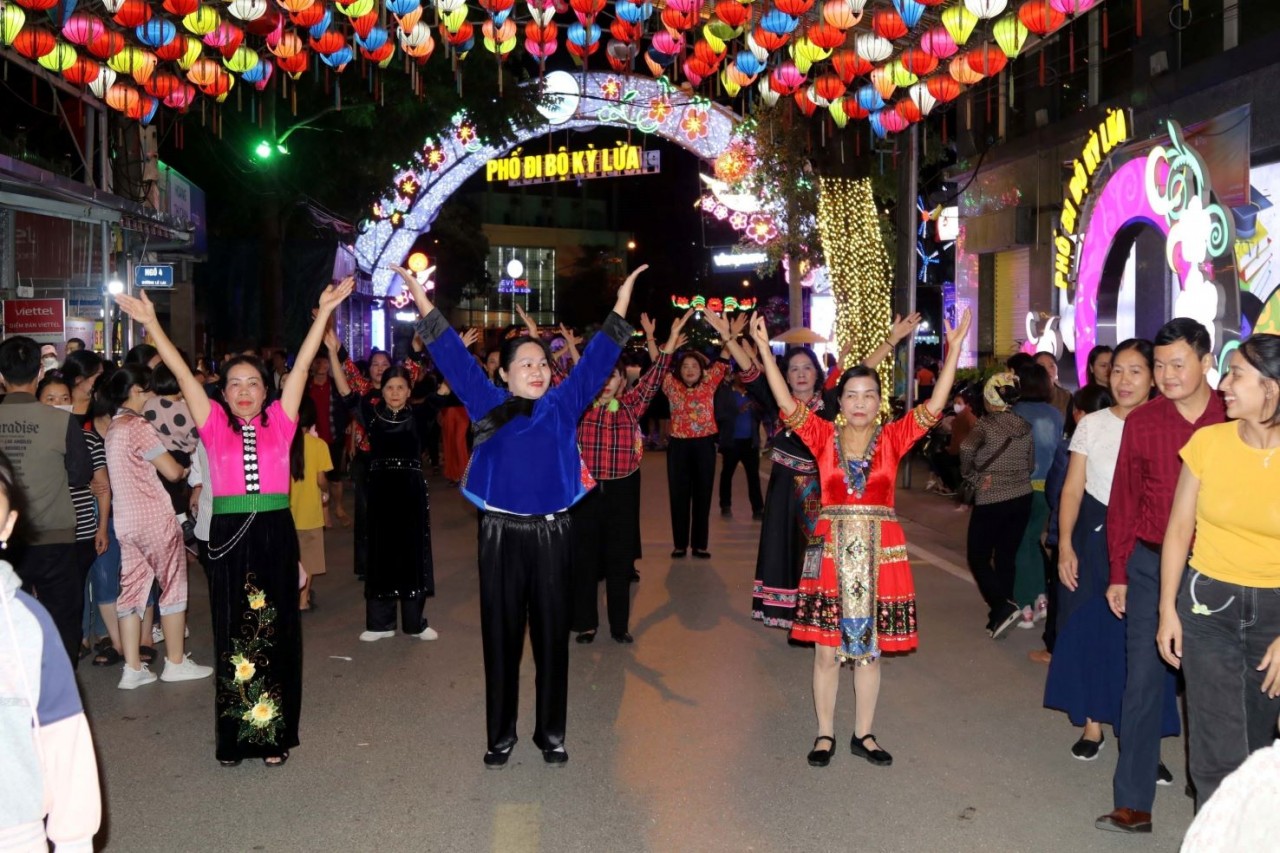
Preserving the language of the Tay and Nung ethnic groups of Lang Son
Latest
 |
| People’s Artist Ha Mai Ven taught the Nung ethnic language to the younger generation. |
The whole province currently has 7 main ethnic groups living together (Nung, Tay, Kinh, Dao, San Chay, Hoa, Hmong), of which the Tay and Nung ethnic groups account for nearly 80% of the province’s population. Both ethnic groups have their own languages belonging to the Tay – Thai language family. Currently, the main language used is still Vietnamese (Kinh), however, in villages where many Tay and Nung people live, people still use the ethnic language for daily communication. Like many other ethnic groups, the language of the Tay and Nung people of Lang Son exists in two forms: written and spoken.
An important element that creates Lang Son cultural identity
Regarding language, the Tay and Nung Lang Son people have had long-standing contact with the Kinh people. The Tay people learned Chinese characters according to Sino-Vietnamese sounds, so the Tay language is more influenced by the Kinh language and closer to the Kinh language. In the past, Nung people often learned Chinese characters according to Chinese sounds, so their language was closer to Chinese. Therefore, the Tay and Nung people can understand each other in communication but there is a subtle distinction between the Tay and Nung languages in terms of tone. Phonetically, the Nung language often has some Chinese words indicating family relationships that are not found in the Tay language.
Regarding written language, in the book “Traditional culture of Tay and Nung” by the group of author: Hoang Quyet – Ma Khanh Bang – Hoang Huy Phach – Cung Van Luoc – Vuong Toan mentioned that, in Lang Son around the 17th – 18th centuries, The Tay people created the Tay Nom script, the Nung people also created the Nung Nom script to record poetry, folk tales, contracts, purchases, transfers, and land records of customs, practices, beliefs, history, geography and literary works… In 1961, the Government promulgated the Tay and Nung writing system throughout the country, including Lang Son, following the Latin character model. Currently, the Tay and Nung ethnic groups no longer maintain their own writing, only a small part of the system of ritual books and Then books remains.
Mr. Hoang Van Pao, Chairman of the Provincial Cultural Heritage Association said: Tay and Nung are two ethnic groups that share many similar characteristics in ethnicity, residence, culture, especially language. People often use their own language anytime, anywhere, in daily life when talking to each other. At all Ky Lua markets, the majority of people who go to the market use Tay and Nung languages as the main means of communication to exchange, buy and sell goods and sing Sli, Luon to express love to each other. Every time the sounds like noong (me), chai (you), pay hang (go to the market), kin khau (eat rice)… the listener will immediately recognize that they are the Tay and Nung ethnic groups. It can be said that the Tay and Nung languages, both spoken and written, are important elements that create Lang Son’s cultural identity.
| At the National Cultural Conference implementing the Resolution of the Party’s 13th National Congress taking place in November 2021, Party General Secretary Nguyen Phu Trong emphasized: “Pay more attention to preserving, embellishing and promoting national cultural values, tangible and intangible cultural values of regions and ethnic groups, combined with absorbing the cultural quintessence of the times”. Accordingly, the languages of ethnic groups in general and the Tay and Nung ethnic groups in particular are valuable cultural heritages that need to be preserved and promoted. Realizing this, over the years, all levels, sectors and people have come up with many practical solutions. |
Strengthen propaganda and teaching
Mr. Phan Van Hoa, Deputy Director of the Department of Culture, Sports and Tourism said: We direct specialized departments and affiliated units to increase the collection of documents, written artifacts, and audio and video recordings of customs, practices, and folk songs using the Tay and Nung languages; compile works, extract excerpts from ancient keys, village mandarins, hot pot grass, sli and publish them into books to archive and serve the people’s research work. At the same time, we guide districts and city to promote propaganda, encourage people to use ethnic languages in daily life, and encourage the older generation to teach them to the younger generation; promote the establishment of folk song clubs, this is an ideal environment for the language to be maintained and promoted effectively.
Not only the Culture, Sports and Tourism sector, other agencies and units in the province are also very interested in preserving ethnic languages. Specifically: Lang Son Pedagogical College has opened training Tay and Nung language certificates classes (implemented since 2011), mainly teaching Tay language for officials, civil servants and candidates for the civil service exam according to regulations. These training classes are all approved by the Department of Education and Training.
 |
| A cultural performance at Lang Son walking street, Lang Son city. (Photo: VNA) |
Mr. Nguyen Cac Tam, Director of the Center for Foreign Languages and Information Technology, Lang Son College of Education said: On average, each year, the school opens from 2 to 7 training classes for hundreds of students in the province. In particular, in 2020, the School was ordered to compile and edit Tay language documents for officials, civil servants and public employees throughout the province, by 2021, the documents were approved by the Provincial People’s Committee and widely used in the province. In 2023, we are teaching 2 Tay language classes with over 100 students.
| Language is the soul of each nation, losing the mother tongue is similar to the risk of losing the soul and cultural identity of that nation. |
In addition, the Provincial Radio and Television Station has broadcast news bulletins, current affairs programs and cultural programs in the Tay – Nung language. Television programs in Tay – Nung languages are also broadcast on Tuesdays, Thursdays, and Saturdays/week to serve the people. In particular, since 2018, the Provincial Radio and Television Station has opened a folk song teaching section on television with 1 issue/month, mainly programs teaching Then and Sli singing of the Tay – Nung people. From the beginning of 2023 until now, the Provincial Radio and Television Station has broadcast more than 200 numbers, attracting tens of thousands of people to pay attention and watch.
At the same time, Xu Lang Literature Magazine regularly publishes literary and artistic works in Tay and Nung languages. Specifically, each month the Magazine releases 1 issue, in which each issue publishes 2-3 works of poetry, stories or folk songs in the Tay and Nung languages. In addition, many works of poetry and prose by members of the Lang Son Literature and Arts Association were printed and published, contributing to preserving the Tay, Nung, and Tay languages, every year, 1-2 bilingual literary books are published, with diverse and rich topics, clearly changing forms, increasingly approaching modern poetry but still retaining its own nuances, for example, the bilingual short story collection Tay – Vietnamese (Tang/Doi) printed in 2013 with 5 short stories by author Hoang Kim Dung; Tay-Vietnamese bilingual poetry story collection (Nguoi cam luon mua Tran Ninh/Send luong verses to Tran Ninh) printed in 2014 with more than 1,500 verses and the bilingual poetry collection Tay – Nung, Vietnamese (Tam chu pa chu me/Land is father and mother) printed in 2016 with 23 poems by author Hoang Choong…
Notably, the work of preserving ethnic languages through cultural and artistic activities using Tay and Nung ethnic languages such as then singing, sli, luon… is also taught in extracurricular classes by many schools in the province. To date, the whole province has 23 schools at the elementary, middle, and high school levels that have been organizing teaching and establishing then and gourde lute singing clubs attracting over 400 students, an increase of 60% compared to 2018...
Language is the soul of each nation, losing the mother tongue is similar to the risk of losing the soul and cultural identity of that nation. With positive solutions from all levels and sectors in the province, we will gradually contribute to preserving and promoting the Tay and Nung ethnic languages in the current period.

















